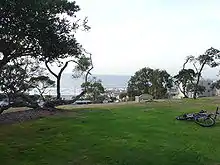Bruce's Beach
Bruce's Beach was a beach resort in the city of Manhattan Beach, California, that was owned by and operated for African Americans. It provided the African American community with opportunities unavailable at other beach areas because of segregation.

As a result of racial discrimination from disgruntled white neighbors, the property was seized using eminent domain proceedings in the 1920s and closed down. Some of the area was eventually turned into a city park in the 1960s and renamed Bruce's Beach in 2007.
History
While many historians credit George H. Peck (1856–1940), a wealthy developer and the founder of Manhattan Beach, for having "bucked" the practice of racial exclusion,[1] Peck created barriers to deter Black out-of-town visitors to Bruce's Beach. To reach the ocean, visitors had to walk an extra half mile around property owned by Peck, who had lined it with security and “No Trespassing” signs.[2]
Willa and Charles Bruce bought a property in the strand area for $1,225 that was set aside from Henry Willard in 1912, and added on three lots.[1] They established a resort and named it for Mrs. Bruce.[3]
The development included a bathhouse and dining house for blacks, whose access to public beaches was highly restricted.[4] Aside from the blacks-only beach resort, Manhattan Beach was "an otherwise lily-white community" and blacks only had limited access to beaches; Mrs. Bruce's initiative "defiantly transgressed these racial boundaries."[5] It was not the only beach attraction available to black people; there was also Peck's Pier and pavilion on 34th Street,[6] a section of Santa Monica State Beach referred to as the "Ink Well", and the Pacific Beach Club in Orange County. As Los Angeles's population increased and property values soared in the 1920s, black people in the area suffered from increased racial tension, before eminent domain proceedings started by the city forced the club to close down.[1]
Modern history
In the 1920s, the resort was attacked by the Ku Klux Klan in an attempt to get the city to take back the land from the rightful owners, the Bruce family. Under the pretense of building a city park, the city of Manhattan Beach did take the land away from the Bruce family, and African Americans were run off the land.[7] It was not until 2007, practically eighty years later, that this travesty was acknowledged by the city and the beach was renamed Bruce's Beach.[8]
In the 1950s, city officials began to worry that family members might sue to regain their land unless it was used for the purpose for which it had been originally taken.[2] In the 1960s, the property, which had been vacant for decades, was made into a city park first called Bayview Terrace Park, then Parque Culiacan; in 2006, the Manhattan Beach City Council decided to rename the park, "commemorating our community's understanding that friendship, goodwill and respect for all begins within our own boundaries and extends to the world community. All are welcome."[3] It was ceremoniously renamed in March 2007[9] during an event exhibiting "a deep tide of goodwill."[10]
The park is on a slope overlooking the ocean and includes rolling grassy terraces with benches and small trees. It is located a few blocks from the beach, between 26th and 27th Street, and runs west from Highland Avenue to Manhattan Avenue.[3]
Literature
- "What's the Matter with Bruce's Beach". California Eagle. 1927-07-08.[11]
See also
References
- Murphy, Michelle (June 2006). "Parks and Recreation Commission Recommends Changing Park Name" (PDF). The Manhattan Beach Observer. Archived from the original (PDF) on 2011-07-27. Retrieved 2009-12-01.
- Xia, Rosanna (2020-08-02). "Manhattan Beach was once home to Black beachgoers, but the city ran them out. Now it faces a reckoning". Los Angeles Times. Retrieved 2020-08-02.
- Pring, Dawnya (2006-12-07). "City Council wrap". The Beach Reporter. Retrieved 2009-12-01.
- Flamming, Douglas (2006). Bound for Freedom: Black Los Angeles in Jim Crow America. University of California Press. ISBN 978-0-520-24990-5.
- Sides, Josh (2003). L.A. City Limits: African American Los Angeles from the Great Depression to the Present. University of California Press. p. 21. ISBN 978-0-520-23841-1.
- Rasmussen, Cecilia (1996-11-29). "City Smart". Los Angeles Times. p. B.2. Retrieved 2009-12-01.
- Zinzi, Janna A. (August 1, 2020). "The Tragic History of L.A.'s Black Family Beach Havens". Daily Beast. Retrieved August 1, 2020.
- Schoch, Deborah (2007-04-01). "A deep tide of goodwill at Bruce's Beach". Los Angeles Times. Archived from the original on 2020-07-27. Retrieved 2020-07-27.
- "The History of Bruce's Beach, California". Weekend America. 2007-03-31. Archived from the original on 2010-12-06. Retrieved 2009-12-01.
- Schoch, Deborah (2007-04-01). "A deep tide of goodwill at Bruce's Beach; Hundreds gather at a small Manhattan Beach park to commemorate a black couple forced to give up their profitable resort in the 1920s". Los Angeles Times. pp. B.3. Retrieved 2009-12-01.
- Villa, Raúl; George J. Sánchez (2005). Los Angeles & the future of urban cultures: a special issue of American quarterly. Johns Hopkins UP. p. 133. ISBN 978-0-8018-8208-1.
- U.S. Geological Survey Geographic Names Information System: Parque Culiacan
External links
- Bruce's Beach
- The History of Bruce's Beach, radio program on Weekend America
